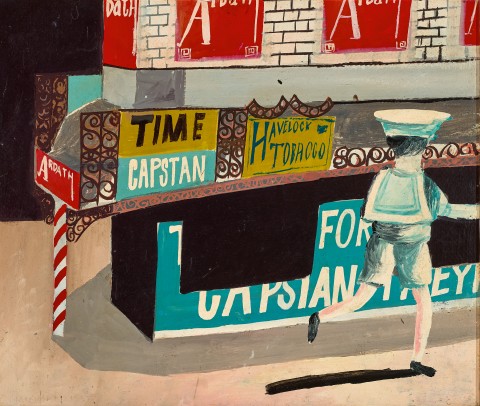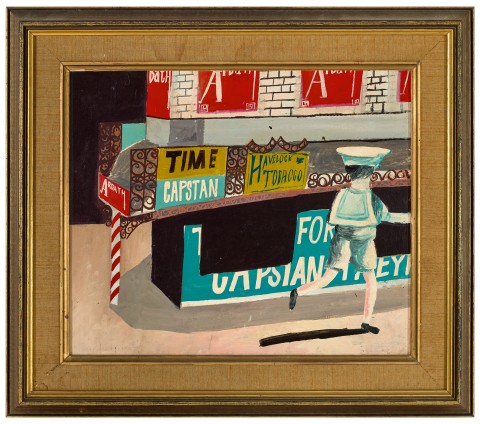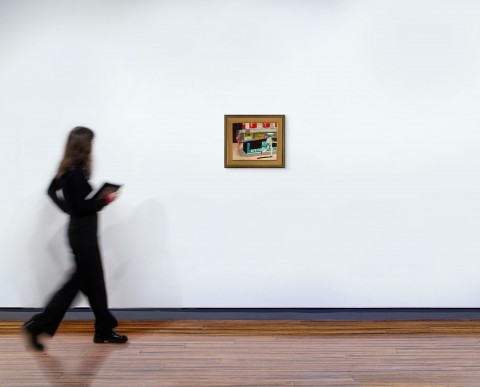SAILOR BOY, 1954
CHARLES BLACKMAN
oil and enamel on cardboard
31.5 x 37.0 cm
signed and dated lower left: BLACKMAN 1954
Mirka's Gallery, Melbourne
Private collection, Melbourne
The Russell Davis Gallery, Melbourne
Private collection, Queensland, acquired from the above in 1974
Blackman Paintings, Mirka's Gallery, Melbourne, 2-13 November 1954, cat. 12
Moonlit in stark white light, the lone figure of a young boy dressed in a sailor suit scurries down a deserted street, past a corner store tobacconist gaudily clad with hand-painted lettering of advertisements for Havelock tobacco; Ardath and Capstan cigarettes. Sailor Boy, 1954 was painted by Charles Blackman in Melbourne within a clear suite of ‘Hoardings’ paintings presented together at a seminal large solo exhibition at his friend Mirka Mora’s studio on Collins St in November 1954, after her daring hosting of an alternative Contemporary Art Society exhibition to rival the Royal Tour Exhibition.1 These ‘impressive experimental paintings’2 synthesised the artist’s personal interactions with the city’s urban landscapes and the disquieting poetic power of flighty and wide-eyed children recently perfected in his ‘Schoolgirls’ series (1952 – c.1954). Rapidly painted with lustrous enamel on composition board, Blackman’s eerie cityscape of creeping shadows is built with pattern of flat unmodulated planes of colour, against which the child seems to float.
The boy, towering over the shop’s awning and facing away from the viewer, moves with light feet out of the picture-frame to the right. The building’s triangular façade, inversely, comes to a point on the lefthand side of the canvas, our attention drawn to this opposing direction by the placement of striped barbershop pole. Painted with the same red as the repeated, truncated, Ardath cigarette logos lining top edge of the painting, these bright features counterbalance the fathomless black shadows running throughout the composition. A similar composition was used within The Cigarette Shop (Running Home), 1954 (National Gallery of Australia), one of the largest works shown at Mirka’s Studio, where a freestanding tobacconist/hairdresser is almost completely obscured by sunny and emphatic advertisements, the night only beginning to encroach.
Continuing his juxtaposition of innocent characters and foreboding built environments, the power of Blackman’s paintings of this period lies in the psychological interaction between stylised children and the implied threats and temptations of the city. Smartly dressed in a miniature sailor’s costume, the boy adopts a vulnerable, well-to-do appearance. Deliberately painted in a naive cartoonish manner, he is caught mid-motion in a distant echo of Félix Vallotton’s child in Le Ballon, 1899 (Musée d’Orsay). Although instead of playfully chasing a ball, the sailor boy ignores the advertisement to hurry toward the safety of a known sanctuary, hastening like the schoolgirls of John Shaw Nielson’s influential and much-quoted poem.3
Prefiguring Pop Art by almost a full decade, Blackman’s ‘Hoardings’ paintings had their origin in his own background of commercial art at the Sun newspaper and the influence of artistic peers, including Robert Dickerson and Danila Vassilieff, whose contemporaneous streetscapes also described the resilience of children inhabiting a harsh suburban environment. Blackman’s landscapes were semi-autobiographical, influenced by his narrated early-morning walks with Barbara, now suffering from low-vision, through Burley and Richmond to Victoria Market.4 Blackman later recalled ‘Perhaps after The Herald Outdoor Art Show, I saw these hoardings on railway stations and factory sites as a fulltime outdoor show in themselves. But also the products and their connotations were a honeycomb of sweet nostalgias which reflected back the gestures of the children I set against them.’5
1. Blackman, B., ‘The Good Ship Mirka’, Meanjin, Winter 1996
2. ‘Art Notes: Experiments in Painting’, The Age, Melbourne, 2 November 1954, p. 2
3. ‘Schoolgirls Hastening’, John Shaw Nielson, cited in Shapcott, T., The Art of Charles Blackman, Andre Deutsch, London, 1989. p. 11
4. St John Moore, F., Charles Blackman. Schoolgirls and Angels, National Gallery of Victoria, Melbourne, 1993, p. 18
5. Charles Blackman, 1993, cited ibid., p. 50
LUCIE REEVES-SMITH


